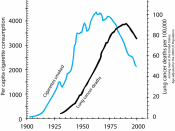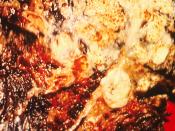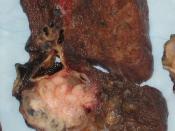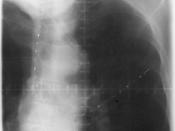Lung cancer is the most common cancer-related cause of death among men and women. Lung cancer can be undetected for many years causing it to become more dangerous and possibly fatal. There is not cure for lung cancer or any cancer, but if detected in an early stage the lung cancer can be detected, treated, and hopefully terminated. There are many new and developing treatments being tested now that may save lives in the future. Through understanding what the lung cancer is, doctors can easily diagnose and assess cancer patients.
Lung cancer takes many years to develop. The characteristics of lung cancer the same as any type of cancer but it effects the lungs. Lung cancer is caused by expose to carcinogens or cancer causing materials. After the carcinogens get into you lungs through breathing, the lining of your lungs will develop microscopic usual cells. If the exposure of the carcinogens to the cells increases, the cells will become more cancerous and will start to spread.
Each infected cell will not do what it is suppose to do. This can limit the amount of air coming and going into your lungs, preventing the amount of oxygen that gets to your blood.
Smoking is leading cause of lung cancer. Smoking causes more than 80% of lung cancer cases. When you smoke you are taking in more that 4,000 different chemicals, which are all proven to be cancerous. Even if you do not smoke you are still at risk for getting lung cancer. Second hand smoke is just as bad as smoking itself. Each of the harmful chemicals can still enter into non-smokers lungs when they are around smokers. Radon is also a leading cause of cancer. Radon is a radioactive gas that is invisible and odorless. Radon can be found in the surface of the earth. When people come in contact with radon it cause the same results as smoking, the cells be come usual. Thus leads to lung cancer. People can also come in contact with carcinogens while they are at work. Many cancer-causing chemicals can be found in the work place such as asbestos, uranium, arsenic, and petroleum. If you are exposed to these carcinogens for long periods of time, just like smoking or radon, you will develop lung cancer.
In the early stages of lung cancer it is hard to detect the cancer. The cancer is silent and can grow and develop for years undetected. When the few symptoms of lung cancer occur, the cancer is usually very developed and often very deadly. Some symptoms are minor while others are very apparent. Some symptoms of lung cancer are chronic cough, chest pain, hoarseness, wheezing, swelling in the face and neck, weight loss, fever, loss of appetite, and shortness of breath.
A doctor can diagnose lung cancer through many tests. The doctor can have x-rays and CAT scans done to see what the inside of the lungs look like. By doing this that doctor is able to see what stage the cancer is in. A doctor may also do a test called a bronchoscope. This test allows the doctor to look inside the bronchial tubes and biopsy the tumor. The doctor then can take a small amount of the cells to study them to determine if the unusual cells are cancerous. If the cells turn out to be cancerous then the patient is in for many months even years of harsh treatment.
Surgery is the most common method used to treat lung cancer followed by chemotherapy or radiation. Surgery can be used if the cancer is benign. Surgery removes the cancer inside the patient. Although surgery is the most popular method, the chance of the doctor being able to remove all of the cancer is highly unlikely. Since the cells are so small and there are thousands of them it is very difficult to remove every one. When a patient uses surgery to treat the cancer, the cancer has a good chance it can come back, because it only takes a few bad cells to spread and create a tumor.
One other treatment for lung cancer is radiation. Doctors can use radiation before surgery to shrink a tumor. After surgery, radiation therapy may be used to stop the growth of any cancer cells that remain. Radiation is a special kind of energy carried by waves or a stream of particles. Radiation uses high-energy rays or particles to treat cancer when used in high doses. The high doses of radiation can kill cells or keep them from growing and dividing. Radiation therapy is also used to shrink tumors and reduce pressure, bleeding, pain, or other symptoms of cancer. Radiation therapy can be external or internal. In external therapy, a machine directs the high-energy rays or particles at the cancer and the normal tissue surrounding it. Internal radiation therapy uses a radioactive substance. This substance is sealed in small containers called implants. The implant is placed directly into a tumor or inserted into a body cavity. These containers kill off any cells that remain after a surgery. The most common side effects are fatigue, skin changes, and loss of appetite. These side effects may go away weeks after the radiation therapy. During radiation therapy, the body uses a lot of energy healing itself. Sometimes radiation therapy can also cause low white blood cell counts, this can cause the patient to be very prone to illness. Another treatment for lung cancer is chemotherapy.
Chemotherapy is the use of drugs to treat cancer. The drugs often are called "anticancer" drugs. Anticancer drugs destroy cancer cells by stopping them from multiplying. Because some drugs work either together chemotherapy often may consist of many drugs. Some side effects of chemotherapy are nausea, vomiting, hair loss, fatigue, sexual compactions, and diarrhea. Chemotherapy can also make you more likely to get infections. This happens because most anticancer drugs affect the bone marrow and decrease its ability to produce white blood cells.
There is no cure for lung cancer, but current research is making the possibly for a cure in the future. One type of promising research is called Photodynamic Therapy. PDT is a new investigation underway. PDT treats many different types of cancer including lung cancer. During this procedure of PDT, a bronchoscope is inserted through the patient's mouth and is directed into a bronchus. An optical fiber is threaded through the bronchoscope. When the laser is turned on, light shines from the end of the optical fiber on the tumor. Red light is used for PDT because it penetrates more deeply into tissue than other colors or wavelengths. This light causes the tumor to break down. One of the main advantages of PDT in lung cancer is that it works quickly within days and PDT can work in places where surgery would not be easy. Another advantage of PDT is it can be repeated a number of times, unlike radiation and chemotherapy. This allows physicians to repeatedly treat tumors and control their growth. There is also no damage to organs or healthy tissues, as occurs with radiotherapy or chemotherapy. Research is being done to find ways to increase the depth of penetration with new photosensitizing drugs and different wavelengths of light.
Along with advantages PDT also has side effects. The major side effect of PDT is photosensitivity, or sensitivity to light. The photosensitizing drug currently used for PDT stays in the skin for about 4-6 weeks. During this time period, the patient must be careful not to get too much exposure to bright light like sunlight. Many people develop temporary skin darkening, much like having a suntan. Pain is another side effect of PDT. As the diseased tissue breaks down, it causes inflammation, which can cause pain. Fortunately, the pain of PDT is usually mild and is easily controlled with a painkiller. Another side effect of PDT for lung cancer is shortness of breath. This is from the fluid buildup in the lungs after the treatment. It is also caused by the inflammation when the cancer is broken down and removed from the body. The good news about the side effects of PDT is that they are usually temporary.
Although lung cancer is the most common form of cancer many new treatments, as well as old treatments, give lung cancer patients a chance at survival. There are many causes of cancer, mainly by being exposed to carcinogens. Most of these causes can be avoided. By understanding what causes lung cancer or even simply not smoking you can lower the chance of developing lung cancer. Through understanding what lung cancer is, what causes it, and how it is treated, patients can make the process of fighting lung caner an easier task.





